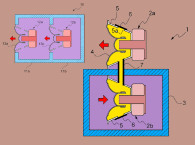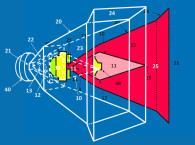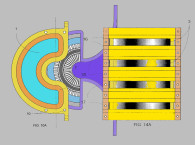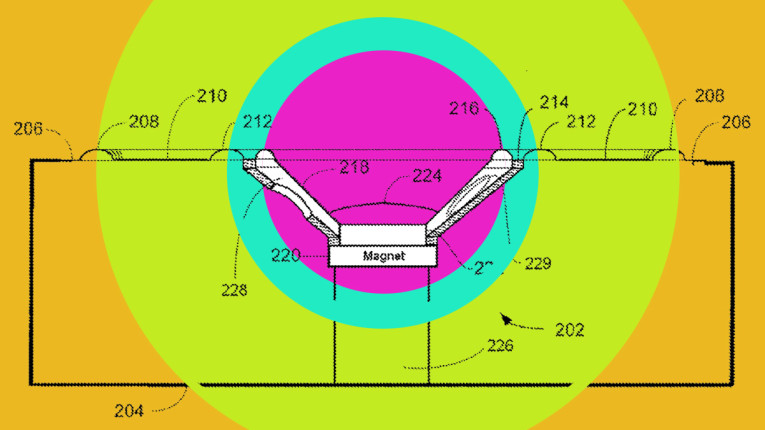
Application Publication Number: 2015/0245122
Inventors: Gary A. Rayner (Henderson, NV) and
James C. Larsen (Bothell, WA)
Assignee: Treefrong Developments, Inc. San Diego, CA
Filed: May 8, 2015
US Classes: 381/152
Granted: August 27, 2015
Number of Claims: 21
Number of Drawings: 12
Abstract from Patent
A loudspeaker includes a rigid enclosure, and a sound projecting region formed in a wall of the rigid enclosure. The sound projecting region includes one or more active driver speakers rigidly connected with the rigid enclosure, the active driver speakers to project sound outward from the sound projecting region and to reflect sound waves within the rigid enclosure. The loudspeaker includes flexible inner surrounds that frame each active driver speaker, and a passive radiator at least partially around the active driver speakers and connected between the inner surround and a flexible outer surround. The outer surround is connected with the rigid enclosure. Electronic circuitry of the loudspeaker includes an audio data receiver to receive audio data, one or more processors to process the audio data, and an amplifier to amplify the processed audio data for playback by the one or more active driver speakers.
Independent Claims
1. A loudspeaker comprising: a rigid enclosure having an outer wall; and a sound projecting region formed in the outer wall of the rigid enclosure, the sound projecting region comprising: a structural support frame securely fixed to the rigid enclosure, one or more active driver speakers each having a voice coil assembly, each voice coil assembly including a permanent magnet and a voice coil movable within the voice coil assembly, each voice coil assembly being rigidly connected with the rigid enclosure to limit movement of the voice coil assembly relative to the rigid enclosure, each active driver speaker further having a driver diaphragm configured to be driven by the corresponding voice coil to project sound waves outward from the rigid enclosure via a front surface of the respective driver diaphragm and to modulate air within the rigid enclosure via rear surfaces of the respective driver diaphragm, an inner surround for each active driver speaker that respectively frames each active driver speaker, the inner surround being formed of a first flexible material, a passive radiator disposed at least partially surrounding each of the active driver speakers, the passive radiator having an opening for each active driver speaker, each opening having an inner edge connected to a respective one of the inner surrounds, the passive radiator having a rigid diaphragm with surface area and a mass that together are configured to tune the passive radiator to have a resonant frequency below a frequency range reproduced by the one or more active driver speakers, the passive radiator configured to enhance at least low-frequency sound waves of the active driver speaker, and an outer surround formed of a second flexible material, the outer surround being connected between a perimeter edge of the passive radiator and the structural support frame of the sound projecting region; and electronic circuitry including: an audio data receiver configured to receive audio data from an external transmitter; one or more processors configured to process the received audio data; and an amplifier configured to amplify the processed audio data for playback by the one or more active speaker drivers.
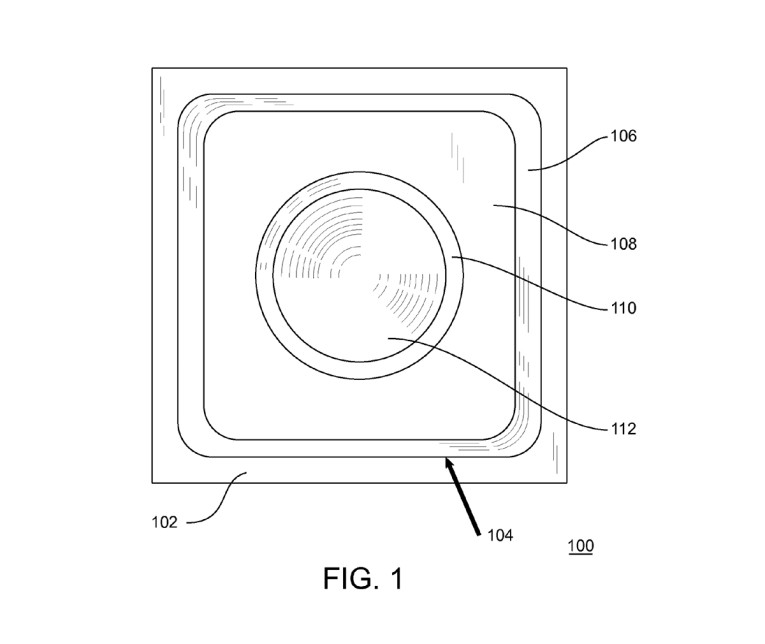
15. A loudspeaker comprising: at least one speaker driver; and control circuitry configured to process a received multi-channel audio signal, the control circuitry including: a first mixer that mixes together all channels of the multi-channel audio signal to provide a first mixed audio signal, a low-pass filter configured to attenuate frequencies above a first predetermined frequency threshold in the first mixed audio signal to provide a low-pass filtered audio signal, for each channel of the multi-channel audio signal, a high-pass filter configured to attenuate frequencies in said each channel that are above a second predetermined frequency threshold to provide respective high-pass filtered audio signals, for each channel of the multi-channel audio signal, a second mixer configured to mix a respective one of the high-pass filtered audio signals and the low-pass filtered audio signal to produce a respective processed audio channel, and at least one amplifier configured to receive and amplify one of the processed audio channels, and to cause the at least one driver speaker to reproduce the processed audio signal.

20. A loudspeaker system comprising: a plurality of loudspeakers, each loudspeaker including a rigid enclosure having an outer wall and a sound projecting region formed in the outer wall of the rigid enclosure, the sound projecting region of each loudspeaker comprising: a structural support frame securely fixed to the respective rigid enclosure, one or more active driver speakers each having a voice coil assembly, each voice coil assembly including a permanent magnet and a voice coil movable within the voice coil assembly, each voice coil assembly being rigidly connected with the rigid enclosure to limit movement of the voice coil assembly relative to the rigid enclosure, each active driver speaker further having a driver diaphragm configured to be driven by the corresponding voice coil to project sound waves outward from the rigid enclosure via a front surface of the respective driver diaphragms and to modulate air within the rigid enclosure via rear surfaces of the respective driver diaphragms, an inner surround for each active driver speaker that respectively frames each active driver speaker, the inner surround being formed of a first flexible material, and a passive radiator disposed at least partially surrounding each of the active driver speakers, the passive radiator having an opening for each active driver speaker, each opening having an inner edge connected to a respective one of the inner surrounds, and a perimeter edge of the passive radiator connected to an outer surround formed of a second flexible material, the outer surround being connected with the structural support frame of the sound projecting region, the passive radiator having a rigid diaphragm with surface area and a mass that together are configured to tune the passive radiator to have a resonant frequency below a frequency range reproduced by the one or more active driver speakers, the passive radiator configured to enhance at least low-frequency sound waves of the active driver speaker; and electronic circuitry including: an audio data receiver configured to receive audio data from an external transmitter, one or more processors configured to process the received audio data, and an amplifier configured to amplify the processed audio data for playback by the one or more active speaker drivers; wherein the electronic circuitry of at least one loudspeaker of the plurality of loudspeakers further includes communication circuitry configured to receive, from at least one of the other loudspeakers of the plurality of loudspeakers, at least one of an identity, proximity data, and location data for the at least one other loudspeaker of the plurality of loudspeakers, and to receive listening position location data, and the one or more processors of the at least one loudspeaker of the plurality of loudspeakers are configured to calculate and apply at least one of a relative loudness level and an equalization setting for the at least one loudspeaker based on the received at least one of identity, proximity data and location data from the other loudspeakers.
Reviewer Comments
In the last few years, there have been several patent filings on new architectures for passive radiators, particularly ones that are used in small, mobile devices. One of the problems is that it is difficult to provide enough diaphragm surface area for the active transducers and the passive acoustic diaphragms.
Some of the more interesting developments have been those by the late Godehard A. Guenther, such as US 8,189,840, “Loudspeaker and Electronic Devices Incorporating Same,” wherein the device battery is configured with a surround suspension to do double duty as both the DC power source and as a vibratile passive diaphragm radiator—providing both the mass and the surface area required for low-frequency, Helmholtz tunings in a small enclosure. Recently, others have attempted to use the active transducer as the passive radiator, (e.g., Joseph Y. Sahyoun’s application publication US2013/0195311, “Acoustic Radiator Including a Combination of a Co-Axial Audio Speaker and Passive Radiator”). Another approach uses both the active transducer and the loudspeaker front baffle as a compound passive radiator, (e.g., Harman International’s WO2013166650A1, “A New Speaker,” by inventor Shengbo Li).
The present invention discloses a loudspeaker with a rigid enclosure and a primary sound-radiating surface. The rigid enclosure includes an outer wall, and the sound-radiating surface is formed in the outer wall and may substantially utilize the entire surface as a vibratile diaphragm. The sound-radiating surface includes a structural support, with the active transducer including an inner surround and; a passive radiator positioned around the circumference of the active transducer, with an inner surround, just outside of, and adjacent the active transducer surround; and an outer surround, around the passive radiator’s outer circumference.
This approach essentially allows the totality of the device enclosure’s surface to be utilized to radiate acoustic output, maximizing the active surface area for a given surface dimension. An attribute is that the backside of the transducer and the frame are mounted to the front panel and secured to a rear panel of the enclosure, stabilizing the structure while allowing the front surface elements to “float” without providing the structural integrity normally associated with the transducer frame mounted to the front baffle panel.
The general approach appears to have been anticipated by a few concentric passive radiators in the prior art, and most specifically by the structure disclosed by Aaron Butters in US 7,158,648 “Loudspeaker System with Extended Bass Response,” assigned to Harman International, which provides a device with essentially the same benefit of maximizing frontal surface area that can be mobilized for acoustic output.
Regardless of who ends up owning the intellectual property, disclosed the passive radiator architecture should be an effective means to realizing the desired increase in output capability commensurate with the expanded vibratable surface area. VC
This article was originally published in Voice Coil, November 2015.



